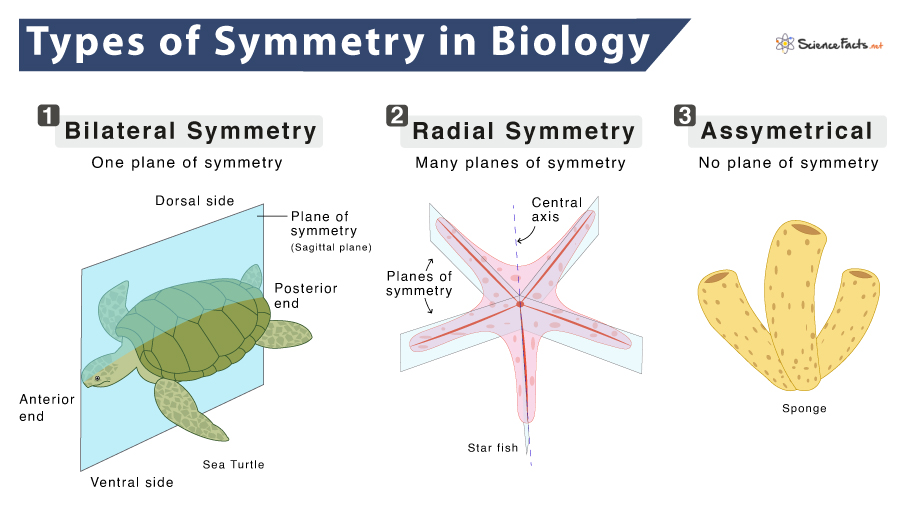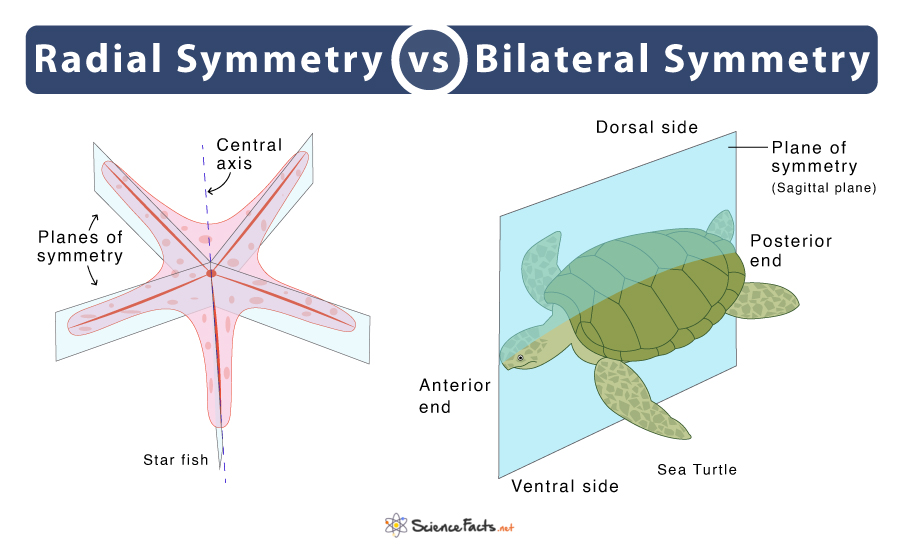Radial vs. Bilateral Symmetry
Symmetry is the arrangement of body parts such that they can be divided equally along an imaginary line or axis. Considering various organisms’ different shapes and orientations, scientists have developed three basic types of symmetry – radial, bilateral, or asymmetrical.
Radial symmetry is the arrangement of body parts around a central axis. It is similar to the sun’s rays or a sliced pie. Radially symmetrical organisms have a top and a bottom surface. However, they do not have left or right sides and separate front or rear portions.
In contrast, bilateral symmetry is a body arrangement that divides the organism into two halves through a sagittal plane. The two halves, left and right, are mirror images. Animals with bilateral symmetry have a head (anterior) and tail (posterior), front (dorsal) and back (ventral), and right and left sides.
Again, in the phylum Porifera (sponges), organisms have no body symmetry and are thus called asymmetrical. These groups of animals share a simple body plan. Sponges have no brains, nerve cells, or organs. Some fish species, like flounder, also lack symmetry as they become adults.
What is the Difference between Radial and Bilateral Symmetry
| Basis | Radial Symmetry | Bilateral Symmetry |
|---|---|---|
| Division into Left and Right Sides | Divides the body into multiple identical halves around the central axis | Divides the body into 2 identical halves (right and left) along the central axis, the sagittal plane |
| Arrangement of Similar Body Parts | Similar body parts are arranged in a similar manner around the central axis | Similar body parts are arranged in the same way on both sides equally |
| Examples | Jellyfish, starfish, sea urchin, and sea anemone | Humans, insects, orchids, and flowers |
| Habitat of Organisms | 1. All are found in water (marine organisms) 2. Less common in animals than bilateral symmetry | 1. Found in both aquatic and terrestrial habitats 2. More common in animals than radial symmetry |
| Characteristics of Organisms | 1. Have many lines of symmetry 2. Have a top and a bottom region but do not have a front or back or distinctive left and right sides. 3. Have a side with the mouth (oral side) and a side without the mouth (aboral side) 4. Move slowly, primarily sessile. 5. Animals can obtain food or evade predators coming from any direction | 1. Have one line of symmetry 2. Have a different head (anterior) and tail (posterior) region 3. Have a top (dorsal) and bottom (ventral) side 4. Move more quickly than animals with a radially symmetrical body plan 5. Animals can obtain food or evade predators coming only from the front |
| 6. Advantages in Organisms | Have poor eyesight and hearing than those with bilateral symmetry | Have better eyesight and hearing than those with radial symmetry |
| 6. Development of Head | It is rare in front of the body | It is commonly found in front of the body |
Conclusion
Bilateral symmetry is the most spread biological symmetry among organisms, particularly in higher and complex organisms. Most animals we know have bilateral symmetry. In contrast, radial symmetry is mainly found in marine organisms and some plants. Also, organisms with bilateral symmetry have some survival advantages over radially symmetrical organisms.
-
References
Article was last reviewed on Friday, February 3, 2023





